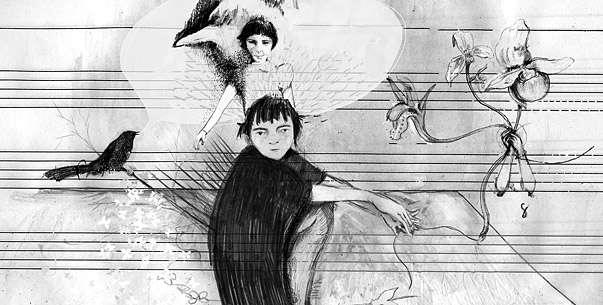|
|
flights of pleasure
does spiritual development require celibacy? Eileen Delahanty Pearkes looks at the nuances of brahmacarya. The 5th of a 10-part series exploring the yamas and niyamas

illustration by cristina sitja rubio
A few merlin hawks live in a small stretch of mature woodland not far from my house. I hear them taking control of the skies each year as the mating season begins. They fill the air with a high-pitched avian laughter somewhere between a hoot and a cackle. They swoop and slice the dome overhead with their sharp wings. Sometimes, they construct their roost in a tall fir tree that stands like a sentinel just down the hill. I like to look up from my tasks in the garden to watch them go about their celestial lives.
When I was walking in the woodland one day, I heard a merlin’s intense chuckle directly overhead. I looked up and, following the noise to the tip of a fir tree, found two merlins, not one. They were locked in a midair mating dance, wings fluttering around them in a feathered tangle. I was spellbound by their balance and poise. Even from my own perch on the ground, I could feel the incredible concentration of energy as they joined with one another without any support of their weight.
The yoga sutras of Patanjali, which outline the various practices that lead to spiritual freedom in a series of aphorisms, discuss a yogi’s use of sexual energy. Patanjali mentions the five yamas, or basic principles of behaviour guiding how an individual should relate to others in the world. The yamas are followed by the niyamas, or principles that guide one’s relationship to oneself. Brahmacarya is the fourth yama, explained in sutra II.38. This word translates variously as “continence,” “chastity” and “celibacy” or more generally as “highest modification of the senses” and “respect for the Divine.” A common interpretation of the original Sanskrit is that with containment of sexual energy comes greater vitality, potency and vigour. This in turn focuses essential energy on spiritual worship and respect.
The freedom of the birds was not lost on me that day, nor was the sense I had of their airy pragmatism, their singular focus on the task at hand, their unfettered, instinctual approach. I couldn’t help but contrast their experience to mine. Mating to perpetuate the species may have been the purpose of sex back in the mists of time, but for thousands of years, human physical intimacy has also been imbued with many other complex cultural experiences: love, pleasure, possession, power and control, to name just a few. In fact, the biological purpose behind sex – the meeting of two sets of cells to form a new life – is an outcome specifically avoided or guarded against by many in the West. The emotionally charged or physically pleasurable aspects of mating often dominate instead.
As raptors, merlins are birds of prey that use their strength and speed to seize and plunder. They are direct and keenly aware. They are more likely to capture and consume small songbirds than nibble politely at seed-heads of grass. Like eagles, falcons and other hawks, they know what they want and they go after it. Their focused stance includes the work of procreation.
For creatures other than humans, annual mating appears to be motivated by a deep-seated instinct to perpetuate the species. It does not get much more complicated than that, whether the creature is a bear, deer, sea otter or hummingbird. In the natural world, the act of copulation is precisely contained by its own purpose. Emotional entanglements, complicated power struggles, hurt feelings and the giving over of precious energy to another do not appear to enter into the process.
And then there is the quasi-natural world of human beings. I seem to be on a different flight pattern altogether from the birds and other wild creatures around me. I often find that I need spiritual guidance for my relationships with others to function at their best, even when it comes to matters of the flesh. How can I allow myself to be influenced by brahmacarya, to learn to love in a constructive way that supports my spiritual development? Does spiritual development necessarily require celibacy?
Eileen Delehanty-Pearkes practises Ashtanga Yoga and lives in Nelson, BC. She is the author of The Geography of Memory and co-author of The Inner Green. Her third book, The Glass Seed, will soon be released by timeless books. Eileen’s exploration of the yamas and niyamas will continue in the next issue as she interprets tapas (or purification).
|

